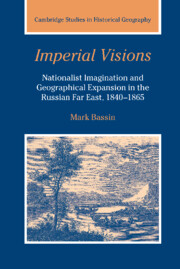 Imperial Visions
Imperial Visions Published online by Cambridge University Press: 06 July 2009
“My ardent love for Russia … will serve as my excuse”
One of the clearest indications of the obscurity surrounding the Amur region in the early decades of the nineteenth century was the fact that practically nothing about the river appeared in print. What was published at the time was located for the most part in a highly specialized literature and directed to a select audience which had some practical reason to be concerned with the Russian Far East. The picture of the region that emerged out of these accounts was unalluring and undistinguished, and moreover was one which carefully accorded with the official position of the government. The most extensive of these treatments – Grigorii Spasskii's 1824 essay “Historical and Statistical Notes about Places along the River Amur” – offered a good example of this latter point, for although the author made it clear that Russia had relinquished the region to China in the late seventeenth century, he did not comment on the injustice of the Treaty of Nerchinsk and did not even allude to the issue of reacquisition. Elsewhere Spasskii did discuss the value of the Amur in a manner that had rather more contemporary overtones, by indicating the region's potential importance as a supply base for Russia's North Pacific settlements, but again he did not call for the reacquisition of the Amur, even in muted tones or by implication.
To save this book to your Kindle, first ensure [email protected] is added to your Approved Personal Document E-mail List under your Personal Document Settings on the Manage Your Content and Devices page of your Amazon account. Then enter the ‘name’ part of your Kindle email address below. Find out more about saving to your Kindle.
Note you can select to save to either the @free.kindle.com or @kindle.com variations. ‘@free.kindle.com’ emails are free but can only be saved to your device when it is connected to wi-fi. ‘@kindle.com’ emails can be delivered even when you are not connected to wi-fi, but note that service fees apply.
Find out more about the Kindle Personal Document Service.
To save content items to your account, please confirm that you agree to abide by our usage policies. If this is the first time you use this feature, you will be asked to authorise Cambridge Core to connect with your account. Find out more about saving content to Dropbox.
To save content items to your account, please confirm that you agree to abide by our usage policies. If this is the first time you use this feature, you will be asked to authorise Cambridge Core to connect with your account. Find out more about saving content to Google Drive.